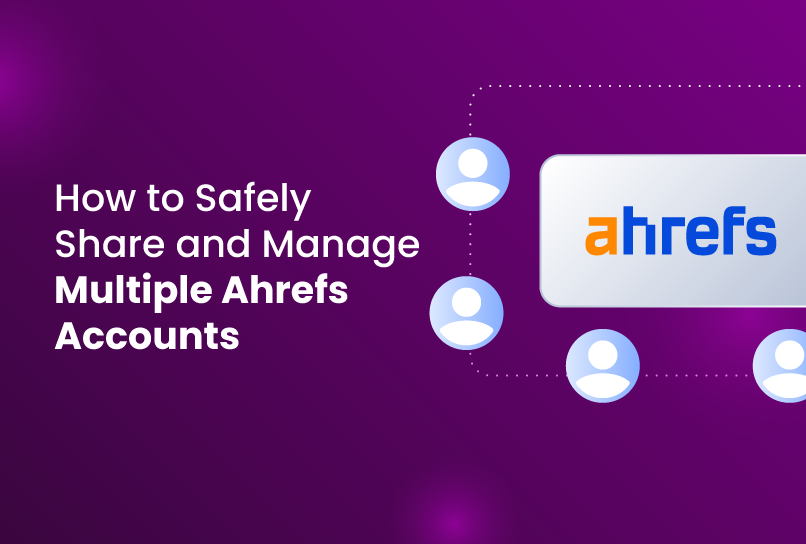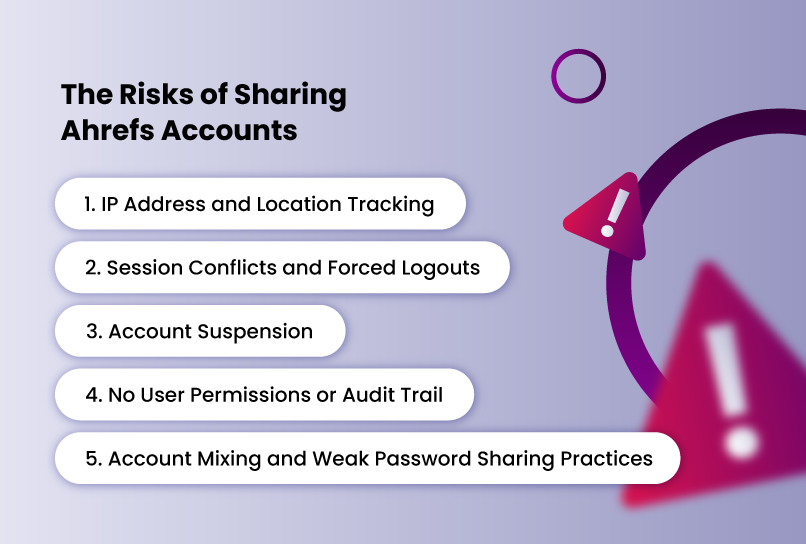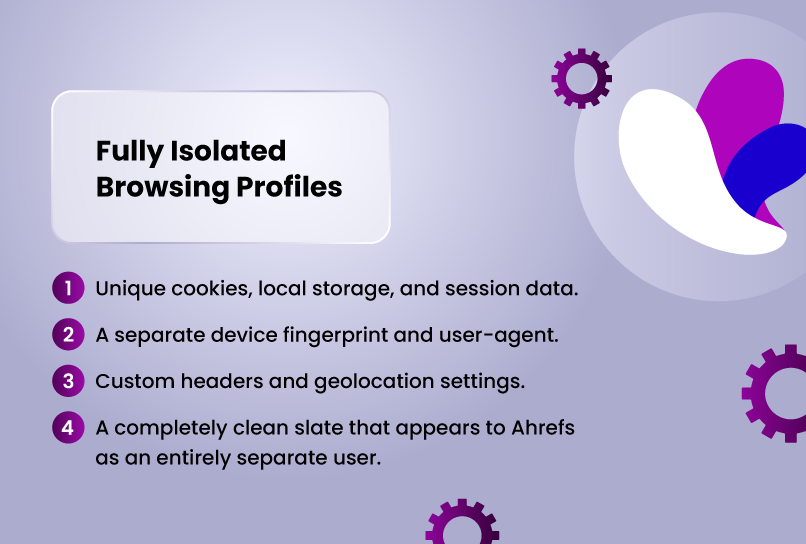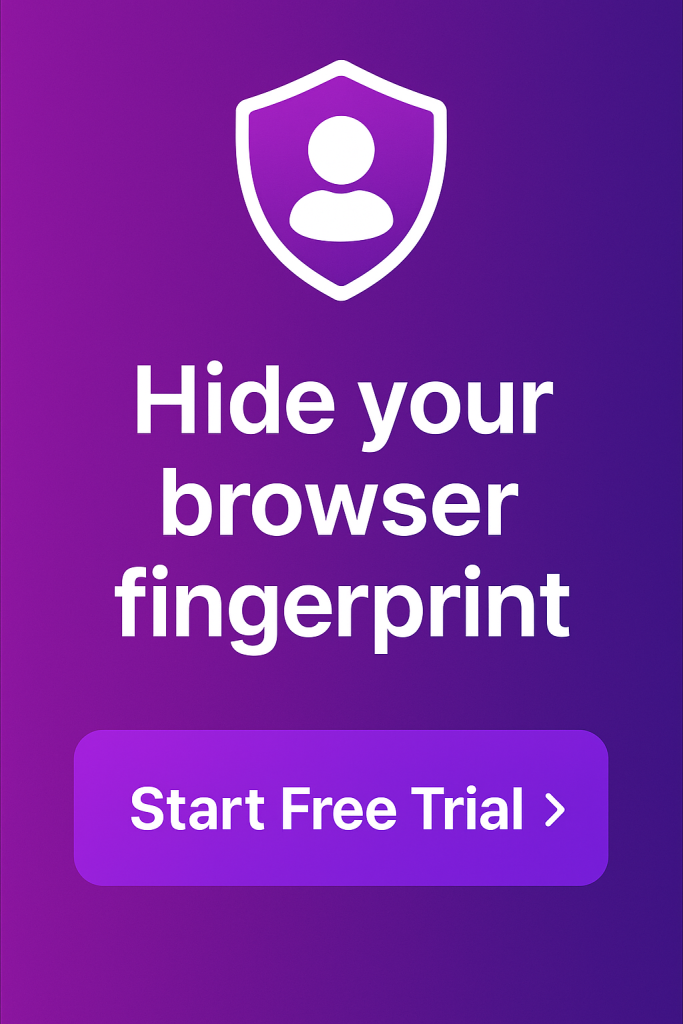Ahrefs powers SEO for over 50,000 teams worldwide, but it’s not very affordable — subscription starts at $129/month. For small teams, freelancers, agencies, and even clients who only need temporary access, the idea of sharing an Ahrefs account is tempting.
Why pay hundreds of dollars per month for each person when you could split access? The answer — it’s not that straightforward. Ahref actively monitors logins, flags suspicious activity, and may restrict access if it detects multiple users logging in from different locations or devices. Worse, if you violate their terms of service, your entire account could be suspended permanently.
So, how do you balance the need to collaborate with the risk of getting banned? This article explores everything you need to know about sharing Ahrefs accounts safely. We’ll walk you through the risks, best practices, and smarter alternatives like Incogniton’s team collaboration feature, which lets you manage access without repeatedly logging in or sharing passwords.
Whether you’re a solo consultant or part of a global SEO team, this guide will help you navigate Ahrefs access without putting your account at risk.
Why People Share Ahrefs Accounts
If you’ve ever looked at the pricing page for Ahrefs, you already know why so many people look for ways to share access. Plans start at over $100/month, and the most useful features — like Site Audit, Rank Tracker, or Keyword Explorer — are locked behind higher-tier packages. Add multiple users, and the cost balloons quickly.
Here are the most common reasons people share Ahrefs accounts:
To Cut Costs. Startups, freelancers, and small SEO agencies often don’t have the budget for full multi-user plans. Sharing an account becomes a practical solution to access powerful SEO data at a lower cost.
For Collaboration. Many SEO projects are team efforts. You might have strategists, content writers, link builders, and analysts working on the same project. Rather than each person buying a seat, they share credentials to access a single account.
For Temporary or Client-Based Access. Sometimes clients want to view performance metrics or hire an SEO expert for a one-time audit. In these cases, handing over access for a few days (or weeks) might seem reasonable, especially when creating a separate user account isn’t an option.
To Get Around Seat Restrictions. Ahrefs doesn’t offer unlimited team seats unless you’re on a high-tier plan. Users often try to get around this by logging in from different devices and locations with the same login details.
The Risks of Sharing Ahrefs Accounts
Let’s get this out of the way: sharing an Ahrefs account with multiple people is against their Terms of Service. This includes giving your login to a freelancer, using the same account across different agencies, or logging in from several countries at the same time.
At first glance, sharing your Ahrefs login with a teammate or collaborator might seem harmless. However, Ahrefs’ help documentation makes it clear that each plan is intended for a specific number of users—and they actively monitor accounts to enforce this. While it might work for a while, shared accounts often get flagged, leading to forced logouts, temporary blocks, or even permanent bans without warning.
Beyond platform rules, account sharing can create serious workflow and security problems. These are some of the biggest risks you’ll face:
1. IP Address and Location Tracking
Ahrefs monitors logins and automatically flags unusual behavior. If you log in from Nigeria in the morning, and someone else logs in from the UK five minutes later, that’s a red flag. The system might send security alerts, force a logout across all devices or temporarily lock the account for “suspicious activity.”
2. Session Conflicts and Forced Logouts
Ahrefs doesn’t support multiple concurrent logins from the same account on different devices. If two users try to access the account simultaneously (for example, one running a site audit while another checks backlinks) one session might override the other, leading to forced logouts or lost progress.
3. Account Suspension
Persistent violations, like frequent IP changes due to repeated logins from different continents, can get your account suspended. In some cases, Ahrefs has refused refunds even when paid plans were terminated for TOS breaches.
4. No User Permissions or Audit Trail
When multiple people use a single login, there’s no way to tell:
- Who exported what data
- Who made specific changes
- When a keyword list or project was modified
This creates confusion and undermines accountability, especially in agency or client-facing work.
5. Account Mixing and Weak Password Sharing Practices
Sharing your Ahrefs credentials over email, Slack, or even Google Docs is risky. Once credentials leak, anyone can gain access, including ex-employees, competitors, or bad actors. Ahrefs doesn’t support role-based access control, so whoever logs in can see everything.
Why VPNs, Proxies, and Multiple Browsers Don’t Work
Some users try to sidestep Ahrefs’ detection systems by using the same VPN location, running logins through rotating proxies, or juggling multiple browsers. The logic is simple: if everyone appears to log in from the same place (or on a different browser), maybe the platform won’t notice.
Unfortunately, this approach is unreliable for several reasons:
- VPNs don’t hide device fingerprintsEven if your IP matches, Ahrefs can still detect differences in hardware, operating system, browser version, and other unique identifiers.
- Cheap or public proxies are often flaggedMany are already blacklisted, triggering bot detection or login blocks before you even get to the dashboard.
- Multiple browsers share local system dataSwitching between Chrome, Firefox, or Edge doesn’t mask the fact that they’re all running on the same device, with overlapping identifiers.
- Concurrent sessions still cause conflictsEven if everyone logs in from the same IP, Ahrefs can terminate or restrict multiple simultaneous logins.
At best, these tactics work inconsistently. At worst, they create new technical headaches while still violating Ahrefs’ Terms of Service.
How Incogniton Solves These Issues and Enables Sharing Ahrefs Accounts Safely
If you find yourself in a position where sharing an Ahrefs account is unavoidable — and you want to avoid the constant headaches of juggling logins, wrestling with unreliable VPNs, or risking exposure of your credentials — Incogniton is the ideal solution for two key reasons:
- It allows secure sharing at the browser level through its team collaboration feature.
- It gives you true browser profile isolation and consistency across sessions, no matter where you are.
Let’s break that down.
Incogniton is an anti-detect browser built for genuine privacy and anonymity online. It’s designed with advanced anti–browser fingerprinting technology to protect against the online tracking methods that platforms like Ahrefs use to track logins and flag unusual activity.
One of the biggest challenges in managing multiple Ahrefs accounts is browser overlap. A standard browser remembers cookies, sessions, and login data across all accounts, making switching between them a constant hassle. Each time you try to access a different account, you typically have to:
- Log out and re-enter credentials.
- Clear cache and cookies.
- Sometimes, use a VPN to avoid IP conflicts.
- Still risk session mix-ups or detection.
Incogniton solves this by isolating every browser profile into its own self-contained environment. Each profile comes with:
- Unique cookies, local storage, and session data.
- A separate device fingerprint and user-agent.
- Custom headers and geolocation settings.
- A completely clean slate that appears to Ahrefs as an entirely separate user.
This means you can manage multiple accounts without friction. No more constant clearing of data, no more tripping over old sessions, just open the right profile and you’re instantly working in a fresh, consistent environment.
But that’s not all. If you create a browser profile in Incogniton where Ahrefs is already logged in, you can share that exact profile with your teammates via the built-in team collaboration feature. They can open it on their own device and access Ahrefs exactly as if they were you — no credentials exchanged, no suspicious logins, and no mismatched device fingerprints.
Each teammate operates from their own isolated profile, so to Ahrefs, it all looks like normal, consistent usage.
This combination of profile isolation and collaboration removes the main red flags that typically come with account sharing, making your workflow smoother and far more secure.
What This Enables You to Do
The benefits go well beyond simply “making it work.”
First, it eliminates account mixing. Having multiple Ahrefs accounts tied to the same browser is a recipe for chaos — from uploading reports to the wrong workspace to dealing with expired sessions or overwriting login tokens. With Incogniton, each profile acts like its own separate device with its own cookies, storage, and fingerprint. That means:
- Saved searches and keyword lists always stay in the correct account.
- Login tokens never overwrite each other.
- Sessions remain stable with no surprise timeouts or re-authentication prompts.
- You dramatically reduce the risk of triggering Ahrefs’ security alerts for unusual login behavior.
Second, it lets you coordinate usage efficiently. Even with multiple accounts set up, smart scheduling ensures your team avoids hitting usage caps or stepping on each other’s work. For example:
- Assign specific usage windows — Team A uses Account 1 from Monday to Wednesday, Team B uses Account 2 from Thursday to Friday.
- Monitor account limits like crawl credits, API requests, and rank tracking to avoid overages.
- Set up automated alerts to warn when limits are close, so you can adjust before hitting hard caps.
With Incogniton’s secure profile sharing and session isolation, you can scale Ahrefs access across your entire team in a way that’s consistent, controlled, and free from the typical performance or security issues of traditional account sharing.
How to Use Incogniton to Share Ahrefs Accounts: A Step-by-Step Guide
Ready to implement this setup in your team? Follow these steps to safely share Ahrefs accounts using Incogniton:
Step 1: Set Up Your Incogniton Account
Sign up at Incogniton.com and choose a plan that supports team collaboration. Then download and install the desktop app.
Step 2: Create a Browser Profile for Ahrefs
Open Incogniton and click “New Profile.”
Configure it with:
- A unique profile name (e.g., “Ahrefs Account A – Team 1”)
- A new fingerprint and user-agent (default is fine unless you need custom settings)
- Proxy settings if you want to manage location/IP (optional)
- Cookies and local storage enabled
Once done, launch the profile and log in to Ahrefs. Allow cookies and complete any 2FA if prompted.
Step 3: Share the Profile with Your Team
Go to the Team Collaboration section in Incogniton. Add your team members by email and assign them the browser profile you created.
You can set permission levels: view-only, edit, or full control, depending on the use case.
Step 4: Team Members Access the Shared Profile
Each team member logs in to Incogniton, sees the shared profile, and launches it on their device. Once opened, they’ll have direct access to Ahrefs. There is no need to log in again.
Conclusion
Sharing an Ahrefs account might seem like a quick fix, but it comes with real risks. From IP tracking and session conflicts to outright account bans, the platform doesn’t take kindly to shared logins. And if you’re running a team, agency, or even just working with one other collaborator, the downsides can easily outweigh the convenience.
Still, collaboration is essential in modern SEO, and tools like Incogniton make this not only possible, but safe. With its team collaboration feature, browser profile isolation, and password-free access, Incogniton gives you the flexibility to work as a team without violating Ahrefs’ terms or getting caught in session chaos.
Bottom line: If you’re serious about SEO and need to work across multiple accounts, don’t rely on password sharing or risky logins. Use tools built for the job to protect your data, your team, and your Ahrefs access.
FREQUENTLY ASKED QUESTIONS
Can you share an Ahrefs account legally?
No. Ahrefs’ Terms of Service prohibit sharing a single login across multiple people — especially if they’re in different locations or organizations. Sharing may result in forced logouts, flags, or account suspension.
Do I need a VPN to share an Ahrefs account?
You might — especially if team members are in different countries. A VPN can help create consistent IP signals, but it won’t protect against session conflicts or TOS violations. Even with a VPN, Ahrefs can detect unusual usage patterns.
Can I manage multiple Ahrefs accounts from one browser?
Not efficiently. Browsers store session cookies, which conflict when switching between accounts. You’ll constantly be logging out and back in. Using separate profiles in Incogniton or another anti-detect browser is the cleanest solution.
What’s the safest way to give someone access to Ahrefs?
The safest approach is using a tool like Incogniton, where you can share browser profiles that already have Ahrefs logged in. This avoids revealing credentials and reduces the risk of location or session-based flags.
Anti-Detect Browser for Multi-Account Management
Manage unlimited virtual profiles for easy multi-account management. Safe and anonymous. Ideal for teams and individuals. Download and try for free now!



